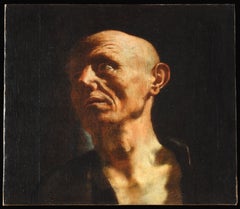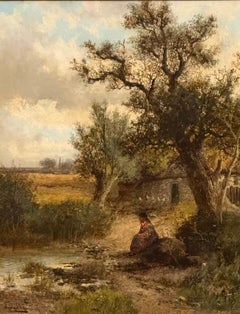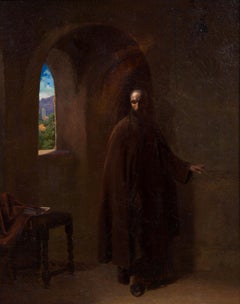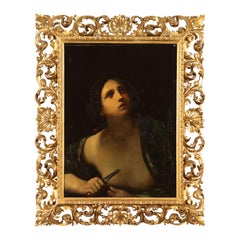Guido Reni Paintings
to
1
1
Overall Width
to
Overall Height
to
1
1
1
1
1
1
1
1
1
1
1
3
781
717
705
691
1
1
Artist: Guido Reni
Early 17th Century by Guido Reni Masculine Head Oil on canvas
By Guido Reni
Located in Milano, Lombardia
Guido Reni (Bologna, Italy, 1575 – 1642)
Title: Masculine Head
Medium: Oil on canvas
Dimensions: without frame 44.7 × 51.2 cm – with frame 62.8 x 68.3 x 5.5 cm
Expertise by Claudio...
Category
Early 17th Century Old Masters Guido Reni Paintings
Materials
Canvas, Oil
$94,156 Sale Price
20% Off
Related Items
‘Near Sutton, Surrey’ stream and old cottage, 19th C/early 20th C oil on canvas
By Abraham Hulk the Younger
Located in Hillsborough, NC
Dutch/English artist Abraham Hulk the Younger (1851-1922) is most known for landscapes of the British countryside. This work is one of a pair (the second work is also available by s...
Category
Late 19th Century Old Masters Guido Reni Paintings
Materials
Canvas, Oil
$2,800
H 27 in W 22.75 in D 2.13 in
Monk in a Monastic Cell, Roma, Italy
Located in Stockholm, SE
Egron Lundgren (1815–1875)
Monk in a Monastic Cell
signed and dated Egron Lundgren Rom 1848
oil on relined canvas
unframed 62 x 50 cm (24 ½ x 19 ¾ in.)
framed 79 x 68 cm (31 x 26 ¾...
Category
1840s Old Masters Guido Reni Paintings
Materials
Canvas, Oil
Landscape Near Felday, Surrey
By Abraham Hulk the Younger
Located in Hillsborough, NC
Dutch/English artist Abraham Hulk the Younger (1851-1922) is most known for landscapes of the British countryside. This work is one of a pair (the second work is also available by s...
Category
Late 19th Century Old Masters Guido Reni Paintings
Materials
Oil, Canvas
$1,960 Sale Price
30% Off
H 27 in W 22.75 in D 2.13 in
Young Christ Pricked by a Thorn (Niño de la Espina)
Located in New York, NY
Provenance: Private Collection, Paraguay, for at least the last 80 years
Painted in the Viceroyalty of Peru during the 18th century, the present work depicts the young Christ as the Niño de la Espina—a devotional representation of Christ as he looks down at his bleeding finger, which has been pricked by the crown of thorns resting on his lap. The subject of the Young Christ Pricked by a Thorn was especially popular in Cuzco, and the rich details and decorative elements of our work perfectly capture the essence and style of the Cuzco School of painting.
In our painting, Christ wears an intricately patterned floor-length robe trimmed with gilded cuffs and a gilded collar. The delicate gilding, including the halo of golden rays emanating from his head, are executed in brocateado, an ornamental over-gilding technique that is characteristic of the Cuzco School. The red chair on which Christ sits also includes brocateado in the decorative gilt elements. The form of the chair takes inspiration from those commonly used by friars both in Spain and the Andes, known as silla frailera or sillon frailero, and was also frequently employed in related depictions of the Virgin Mary Spinning. Here the young Christ is rendered with soft, elongated features that reflect the influence of the Italian Mannerist painters who were pivotal to the formation of the Cuzco School, including the Jesuit friar Bernardo Bitti and Matteo Pérez del Alesio. Additionally, while its origins can be traced to Northern European pictorial traditions, the lush flower garland that frames the work is a signature feature of Cuzqueño painting...
Category
18th Century Old Masters Guido Reni Paintings
Materials
Canvas, Oil
$82,500
H 35.75 in W 23.63 in
Perseus and Andromeda
Located in Paris, Île-de-France
Carle Vanloo (Nice 1705 – Paris 1765)
Perseus and Andromeda
Oil on canvas. H. 081; W. 065.
Alongside François Boucher (1703-1770) and Charles-Joseph Natoire (1700-1777), Carle Vanlo...
Category
1720s Old Masters Guido Reni Paintings
Materials
Oil, Canvas
18th century French Old Master Portrait of a woman in oriental costume
Located in Aartselaar, BE
French 18th century old master portrait of a majestic lady dressed "à la Turque"
The sitter at the viewer with a kind and enigmatic smile and twinkling eyes. She looks elegant and kind, yet also has an intelligent and determined aura, reflecting the character of someone who is in charge of her own life and destiny.
De Silvestre paid great attention to her spectacular outfit, which is striking in its portrayal of the sumptuous fabrics and their decorative richness. She is wearing a luxurious royal blue robe à la...
Category
1740s Old Masters Guido Reni Paintings
Materials
Canvas, Oil
$21,737
H 31.89 in W 25.6 in D 0.4 in
The Archangel Gabriel
By Cristobal de Villalpando
Located in New York, NY
Provenance: Private Collection, Cranston, Rhode Island (by the 1950s?); by family descent until sold at:
Bill Spicer Auction, North Kingstown, Rhode Island, 26 January 2011; where a...
Category
Late 17th Century Old Masters Guido Reni Paintings
Materials
Canvas, Oil
Thomas Hudson Style 18th Century English Portrait
By Thomas Hudson
Located in Roma, IT
Important English school painting in the style of the great artist Thomas Hudson (Devonshire 1701 - Twickenham 1779)
It depicts the portrait of Harry Gray (1715-1768), 4th Earl of St...
Category
1750s Old Masters Guido Reni Paintings
Materials
Canvas, Oil
18th century allegorical painting of The Triumph of Beauty
Located in London, GB
Exhibited:
London, Royal Academy, 1800, no. 93
What was happening in British history painting in around 1800? In recent discussions of the emergence of a British School of history painting following the foundation of the Royal Academy in 1768, this is a question which is rarely posed and one which is not easily answered. Examination of surviving Royal Academy exhibition catalogues reveals a profusion of artists’ names and titles, few of which remain immediately recognizable, whilst endeavours to explain the impact of exhibition culture on painting - such as the 2001 Courtauld show Art on the Line - have tended to focus on the first and second generation of Royal Academician, rather than young or aspiring artists in the early nineteenth century. This makes the discovery and identification of the work under discussion of exceptional importance in making sense of currents in English painting around 1800. Executed by Edward Dayes...
Category
18th Century Old Masters Guido Reni Paintings
Materials
Canvas, Oil
$240,340
H 50 in W 36 in
Shipping in Stormy Waters, Attributed to Italian Artist Francesco Guardi
By Francesco Guardi
Located in Stockholm, SE
The splendour of the tragic sea
Francesco Guardi and maritime painting in Venetian art
No Venetian painter was a stranger to the sea. After all, Venice was not only one of the most prominent ports of the Mediterranean, but indeed a city literally submerged in the ocean from time to time. Curiously however, the famous Venetian school of painting showed little interest in maritime motifs, favouring scenes from the iconic architecture of the city rather than seascapes. That is why this painting is a particularly interesting window into not only the painter Francesco Guardi himself – but to the significance of the element of water in art history, in absence as well as in the centre of attention.
Whether it be calm, sunny days with stunning views of the palaces alongside the canals of Venice or – more rarely – stormy shipwrecking tragedies at sea, water as a unifying element is integral to the works of painter Francesco Guardi (1712–1793). During his lifetime, Venetian art saw many of its greatest triumphs with names like Tiepolo or Canaletto gaining international recognition and firmly establishing Venice as one of the most vibrant artistic communities of Europe. While the city itself already in the 18th century was something of an early tourist spot where aristocrats and high society visited on their grand tour or travels, the artists too contributed to the fame and their work spread the image of Venice as the city of romance and leisure to an international audience, many of whom could never visit in person.
Still today, the iconic image of Venice with its whimsical array of palaces, churches and other historic buildings is much influenced by these artists, many of whom have stood the test of time like very well and remain some of the most beloved in all of art history. It was not primarily subtility, intellectual meanings or moral ideals that the Venetian art tried to capture; instead it was the sheer vibrancy of life and the fast-paced city with crumbling palaces and festive people that made this atmosphere so special. Of course, Venice could count painters in most genres among its residents, from portraiture to religious motifs, history painting and much else. Still, it is the Vedutas and views of the city that seems to have etched itself into our memory more than anything else, not least in the tradition of Canaletto who was perhaps the undisputed master of all Venetian painters.
Born into his profession, Francesco lived and breathed painting all his life. His father, the painter Domenico Guardi (1678–1716) died when Francesco was just a small child, yet both he and his brothers Niccolò and Gian Antonio continued in their fathers’ footsteps. The Guardi family belonged to the nobility and originated from the mountainous area of Trentino, not far from the Alps. The brothers worked together on more challenging commissions and supported each other in the manner typical of family workshops or networks of artists. Their sister Maria Cecilia married no other than the artist Giovanni Battista Tiepolo himself, linking the family to the most renowned Venetian name of the time. During almost a decade, Guardi worked in the studio of Michele Giovanni Marieschi, sometimes simply known as Michiel, a painted similar in both style and motif. Canaletto is, however, the artist Guardi is most often compared to since they shared a mutual fascination for depicting the architecture and cityscape of Venice.
During the course of his career, Guardi tried his hand in many different genres. He was as swift in painting landscapes, Vedutas of Venice, sacred motifs, interiors and architectural compositions as he was in a number of other motifs. His style is typical of the Venetian school but also distinct and personal once we look a little closer. There is an absolute certainty in the composition, the choice of which sometimes feels like that of a carefully calculated photograph – yet it is also very painterly, in the best sense of the word: fluid, bold, sensitive and full of character. The brushwork is rapid, intense, seemingly careless and extraordinarily minute at the same time; fresh and planned in a very enjoyable mixture. His interiors often capture the breath-taking spacious glamour of the palaces and all their exquisite decor. He usually constructed the motif through remarkably simple, almost spontaneous yet intuitively precise strokes and shapes. The result was a festive, high-spirited atmospheric quality, far away from the sterile and exact likeness that other painters fell victim to when trying to copy Canaletto.
The painting here has nothing of the city of Venice in it. On the contrary, we seem to be transported far away into the solitary ocean, with no architecture, nothing to hold on to – only the roaring sea and the dangerous cliffs upon which the ships are just moments away from being crushed upon. It is a maritime composition evoking both Flemish and Italian precursors, in the proud tradition of maritime painting that for centuries formed a crucial part of our visual culture.
This genre of painting is today curiously overlooked, compared to how esteemed and meaningful it was when our relationship to the sea was far more natural than it is today. When both people and goods travelled by water, and many nations and cities – Venice among them – depended entirely on sea fare, the existential connection to the ocean was much more natural and integrated into the imagination. The schools and traditions of maritime art are as manifold as there are countries connected to the sea, and all reflect the need to process the dangers and wonders of the ocean.
It could symbolize opportunity, the exciting prospects of a new countries and adventures, prospering trade, beautiful scenery as well as war and tragedy, loss of life, danger and doom. To say that water is ambivalent in nature is an understatement, and these many layers were something that artists explored in the most wondrous ways. Perhaps it takes a bit more time for the modern eye to identify the different nuances and qualities of historic maritime paintings, they may on first impression seem hard to differentiate from each other. But when allowing these motifs to unfold and tell stories of the sea in both fiction and reality – or somewhere in between – we are awarded with an understanding of how the oceans truly built our world.
In Guardi’s interpretation, we see an almost theatrically arranged shipwrecking scene. No less than five ships are depicted right in the moment of utter disaster. Caught in a violent storm, the waves have driven them to a shore of sharp cliffs and if not swallowed by the waves, crushing against the cliffs seems to be the only outcome. The large wooden ships are impressively decorated with elaborate sculpture, and in fact relics already during Guardi’s lifetime. They are in fact typical of Dutch and Flemish 17th century ships, giving us a clue to where he got the inspiration from. Guardi must have seen examples of Flemish maritime art, that made him curious about these particular motifs. One is reminded of Flemish painters like Willem van de Velde and Ludolf Backhuysen, and this very painting has indeed been mistakenly attributed to Matthieu van Plattenberg...
Category
18th Century Old Masters Guido Reni Paintings
Materials
Oil, Canvas
$69,440
H 25.79 in W 29.14 in
Mid 19th Century "Susanna And The Elders" After The Old Master by Martinelli
Located in San Francisco, CA
Outstanding Mid 19th century old master "Susanna and the Elders" after Martinelli
Brilliant old master painting of Susanna and the Elders.
Original oil on canvas. Dimensions 26.5" ...
Category
Mid-19th Century Old Masters Guido Reni Paintings
Materials
Canvas, Oil
$1,950 Sale Price
58% Off
H 36 in W 26.5 in D 3 in
18th Century European Portrait of Saint John the Baptist as a Child.
Located in SANTA FE, NM
18th Century European Portrait of a Child Saint John the Baptist
Oil on Canvas
19 x 14 1/4 inches
This lovely and sensitively painting has been examined by a professional restorer w...
Category
18th Century Old Masters Guido Reni Paintings
Materials
Canvas, Oil
$6,650 Sale Price
30% Off
H 19 in W 14.25 in D 3 in
Previously Available Items
Copy of Guido Reni's Lucretia, Painting Oil on Canvas 17th Century
By Guido Reni
Located in Milan, IT
Oil on canvas.
Copy of Guido Reni's painting, today preserved at the Gallery of Palazzo Corsini in Florence.
The painting represents the drama of Lucretia's...
Category
17th Century Other Art Style Guido Reni Paintings
Materials
Oil
H 41.74 in W 32.29 in
Guido Reni paintings for sale on 1stDibs.
Find a wide variety of authentic Guido Reni paintings available for sale on 1stDibs.



